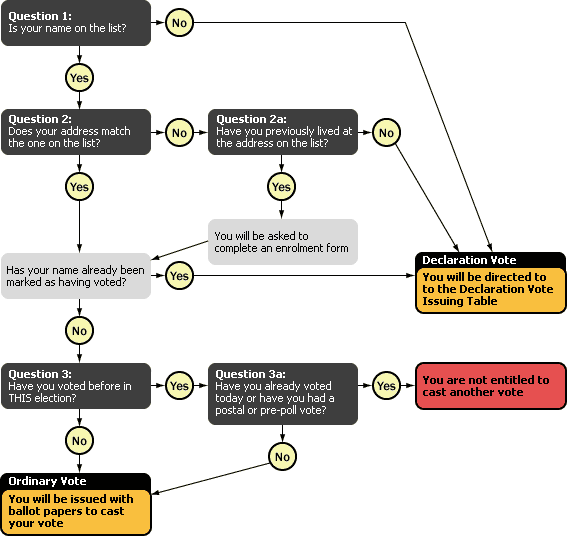Australian Electoral Commission


This page describes the process of voting at a polling place on election day.
Polling day is always on a Saturday. Polling places open between 8am and 6pm and are usually located in local schools, church halls or public buildings.
When you enter the polling place, a polling official will direct you to an issuing table as one becomes available. There you will speak to a ballot paper issuing officer who will ask you a couple of questions before you are issued with your ballot papers.
You will then be directed to one of the polling booths set up around the room for you to cast your vote in private. As you approach the exit there will be two ballot boxes into which you place your completed ballot papers. One is for the House of Representatives ballot paper and the other is for the Senate ballot paper. These will be clearly marked and a person will be at the ballot boxes to assist.
Volunteers from political parties stand outside polling places distributing how-to-vote cards. These cards show voters how political parties or candidates would like you to vote. They may be taken into the polling place to assist in marking ballot papers.
Although how-to-vote cards may encourage voters to mark their preferences in a particular order, the final choice on how to complete the ballot paper is up to you.
This enables the polling official to look up your name on the certified list which is a copy of the electoral roll for that division. If your name is on the certified list, you will be asked the next question.
If the address given is the same as that shown on the certified list you will be asked the next question.
If you have not voted before in this election, you will be issued with ballot papers – one for the House of Representatives and one for the Senate.
If you have voted, you are not entitled to cast another vote and will not be issued with ballot papers.
The polling official will initial each ballot paper on the front near the top right-hand corner.
The polling official will give you your ballot papers when there is a vacant polling booth available so you may mark the ballot paper in secret.
You will be advised to:
For further information on how to complete your ballot papers, please see Voting – House of Representatives and Voting – The Senate.
The doors of the polling place close at exactly 6pm sharp. Any person still in the polling place still has a right to vote. The counting of votes, or 'scrutiny' begins in the polling places as soon as the poll closes.

You are issued a declaration vote if your name and/or address details cannot be found on the certified list used at the polling place at which you have come to vote, or if your name has already been marked as having voted.
The envelope used to seal your ballot papers is called a declaration vote envelope. Your declaration vote ballot papers are inserted into the envelope and forwarded to the division in which you are claiming enrolment. The envelope has a counterfoil which is removed and filed in a 'declaration records' folder. This is a record that you voted at that particular polling place. You 'declare' that you are entitled to vote by signing the envelope.
An absent vote will be issued to you if you are not on the certified list because your enrolled address is outside the division.
A provisional vote will be issued to you if you are claiming to be enrolled for an address within the division but if:
you will be asked to read the provisional voting statement before completing a declaration vote envelope.
The statement is written on the back of the envelope and sets out your rights. After you have read it, it is your decision as to whether you still wish to vote.
The declaration envelope has two sections – one section for you to complete and one for the polling official to complete using the details provided by you in the first section.
You will:
The polling official will: